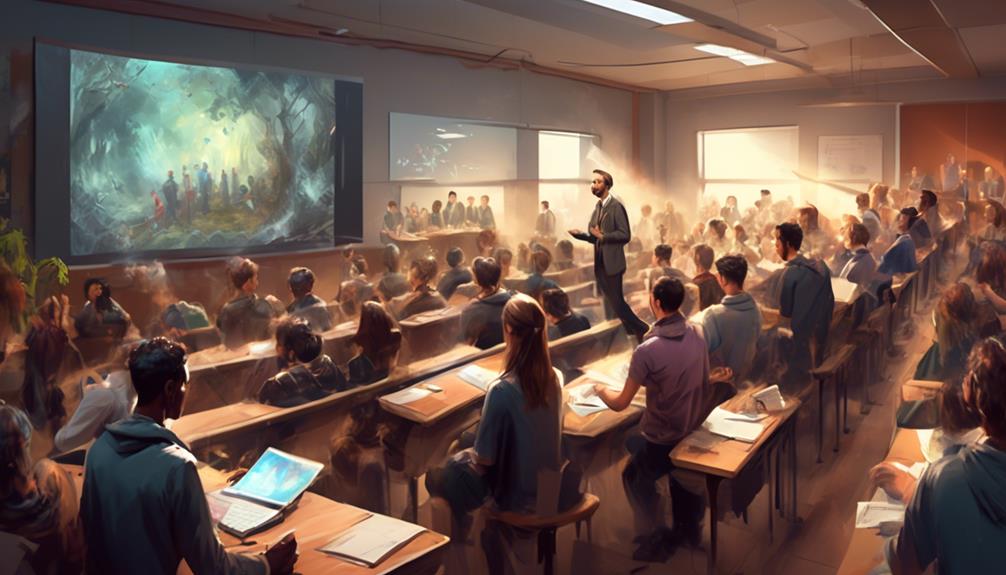Have you ever wondered if livestreaming could revolutionize the way higher education is delivered?
The potential for livestreaming to transform the educational experience is a captivating notion.
As we explore this topic, we'll discuss how livestreaming can address the challenges of accessibility, engagement, and inclusivity in higher education.
Join us as we unravel the impact of livestreaming on the future of learning and discover practical strategies for its effective implementation.
Key Takeaways
- Livestreaming in higher education provides increased accessibility and flexibility for students, allowing them to access content and participate in discussions in real-time from anywhere with an internet connection.
- It fosters a sense of community and collaboration among students, promoting active participation and engagement in the learning process.
- Livestreaming supports diverse student populations and provides equal educational opportunities, allowing students with different circumstances, such as full-time jobs or family obligations, to access education.
- Incorporating interactive features, real-time engagement, and adaptive bitrate streaming enhance the learning experience, making it more dynamic and interactive.
Understanding the Benefits of Livestreaming

Livestreaming in higher education offers numerous benefits, including increased accessibility and flexibility for students. Live Streaming for Education has revolutionized the online learning experience, providing real-time engagement with the content. This learning technology provides insight into various subjects, creating interactive environments that enhance the overall learning experience. Through higher ed live streams, students can participate in discussions and ask questions, fostering a collaborative and dynamic educational atmosphere.
One of the key advantages of Live Streaming in Higher Education is the ability to reach a wider audience. Colleges and universities can transcend geographical barriers, allowing students from different locations to participate in the same educational sessions. This not only promotes inclusivity but also ensures that individuals with diverse circumstances can access quality education. Additionally, livestreaming enables institutions to deliver educational content at convenient times, catering to students' varying schedules and time zones.
Furthermore, livestreaming fosters a sense of community and connectivity among students. Real-time interactions and discussions create an engaging and immersive learning environment, ultimately enriching the overall educational experience. By embracing livestreaming, higher education institutions can truly transform the way knowledge is imparted and accessed.
How to Effectively Use Livestreaming in Higher Education
To effectively utilize livestreaming in higher education, incorporating interactive features and real-time engagement can significantly enhance the learning experience for students. Live streaming offers the opportunity for students to engage in real-time question and answer sessions, interactive discussions, and adaptive bitrate streaming, ensuring a smooth streaming experience even with varying internet bandwidth. This real-time interaction fosters connections and combats feelings of disengagement in online classes, promoting inclusivity and supporting diverse student populations.
Moreover, livestreaming increases accessibility to education, allowing students to overcome barriers such as full-time jobs, family obligations, or health issues. It provides flexibility for students to securely download and review lessons if they can't stream them in real time, supporting convenience and education access from anywhere with a stable internet connection. Additionally, colleges and universities can reach a larger number of students, overcoming obstacles like physical distance and time constraints, and providing equal educational opportunities for students with different circumstances.
Case Studies and Examples

Examples of successful live streaming implementations in higher education showcase the diverse applications and benefits of this technology for both students and institutions. These case studies and examples provide invaluable insights into how live streaming has been utilized in various learning environments within colleges and universities. They highlight the innovative ways in which online video streaming has been leveraged to address challenges and enhance the overall educational experience.
One compelling example is the use of live streaming for virtual practicums, allowing students to gain practical experience in real-time through online platforms. Additionally, counseling services and student support programs have effectively utilized live streaming to provide remote assistance and guidance to students. Furthermore, live streaming has been instrumental in broadcasting sporting events and campus activities, fostering a sense of community and engagement among students, faculty, and alumni.
These examples underscore the potential of live streaming to reach and engage diverse audiences, including prospective students and alumni. By accessing these case studies and examples, educators and administrators can draw inspiration for creatively integrating live streaming into various aspects of higher education, fostering innovation and improvement.
Livestreaming Strategies for Educators
In our experience, implementing effective livestreaming strategies as educators has proven to enhance student engagement and accessibility in higher education. Live streaming offers real-time interaction, making the learning experience more dynamic and interactive.
By utilizing live streaming platforms designed specifically for higher education, such as Higher Ed Live, educators can create a more inclusive and flexible learning environment. One of the key livestreaming strategies for educators is to ensure the use of interactive features to encourage student participation and collaboration. Additionally, incorporating closed-captioning features enhances accessibility for students with hearing impairments.
Integrating live streaming with learning management systems can streamline content delivery and student engagement. It's crucial for educators to use live streaming not only for lectures but also for virtual office hours, guest speaker sessions, and collaborative group discussions. Furthermore, maintaining a balance between live streaming and on-demand content can provide students with flexibility in accessing educational materials.
Enhancing Student Engagement Through Livestreaming

Implementing effective livestreaming strategies as educators hasn't only proven to enhance student engagement and accessibility in higher education but also fosters a more dynamic and interactive learning experience.
Livestreaming in higher education, particularly in online environments, has become a pivotal tool in elevating student engagement. Through live streaming, students are able to actively participate in real-time discussions, ask questions, and receive immediate feedback, creating an immersive learning experience. This interactive approach fosters a sense of inclusivity, as students can engage with the material and their peers regardless of physical location or time constraints.
Furthermore, the use of video in livestreaming allows for observation of facial expressions and body language, which builds trust and connection between educators and students, leading to a more engaging learning experience. Additionally, livestreaming supports adaptive bitrate streaming, ensuring a smooth experience even with varying internet bandwidth, thereby enhancing accessibility for all students.
Leveraging Livestreaming for Virtual Events
Leveraging livestreaming for virtual events in higher education significantly enhances accessibility and fosters real-time connections among students, professors, and participants through interactive features like Q&A sessions and chat options. This approach is especially relevant in the current context of the COVID-19 pandemic, where virtual events have become essential.
In this regard, platforms such as Higher Ed Live, Warpwire, and other online video tools are instrumental in facilitating the seamless integration of live streaming and virtual events within learning environments. By utilizing these tools, institutions can achieve the following:
- Wider Reach: Livestreaming enables higher education institutions to expand their audience, increasing engagement and participation in various events and activities.
- Cost-Effectiveness: It contributes to the affordability of education by providing flexible and convenient access to virtual events, reducing the need for commuting and offering alternative payment models.
- Enhanced Learning Experience: Livestreaming fosters a sense of community, promotes active participation, and facilitates collaboration, thereby enhancing the overall learning experience for students.
Integrating Livestreaming Into the Learning Environment

Integrating livestreaming into the learning environment enhances accessibility and fosters real-time connections among students, professors, and participants through interactive features like Q&A sessions and chat options.
Livestreaming delivers higher ed live, streamed online courses, allowing students to engage with the content in real time. It provides flexibility for students with full-time jobs, family obligations, or health issues, ensuring they can access education from anywhere with a stable internet connection.
Adaptive bitrate streaming guarantees smooth delivery, even with varying internet bandwidth, enhancing the learning experience with interactive discussions and real-time Q&A sessions.
Livestreaming in higher education promotes inclusivity, supporting diverse student populations and providing equal educational opportunities for students with different circumstances. Additionally, it fosters meaningful connections among students and between students and instructors, encouraging active participation and collaboration in the learning process.
Best Practices for Implementing Livestreaming in Education
After exploring the benefits of integrating livestreaming into the learning environment, we can now shift our focus to discussing the best practices for effectively incorporating livestreaming in education.
When implementing livestreaming in education, it's crucial to clearly define the purpose and goals of live streaming to ensure alignment with learning objectives and engagement strategies.
Investing in reliable hardware and software, such as high-quality cameras and a robust network, is essential for ensuring a seamless live streaming experience.
Additionally, providing explicit instructions and guidelines for troubleshooting issues is crucial to support both instructors and students during live streaming sessions.
These best practices focus on enhancing the user experience, managing video within learning environments, and providing low-latency virtual attendee experiences to meet the growing demand for online video.
Frequently Asked Questions
What Is an Academic Stream in Education?
We define an academic stream in education as a live broadcast or recording of educational content, providing real-time or on-demand access to lectures, discussions, and demonstrations. It enhances learning flexibility and fosters engagement.
What Is the Meaning of Streaming in Education?
We see streaming in education as the real-time transmission of audio and video content over the internet, connecting educators and learners remotely. It fosters interactive and engaging experiences, facilitating accessibility and accommodating diverse learning styles and needs.
What Is an Example of a Stream in Education?
An example of a stream in education is interactive virtual classrooms where students engage in real-time discussions and Q&A sessions. It enhances learning by promoting active participation and immediate feedback, fostering a dynamic educational experience.
Is Live Streaming Classrooms a Good Idea?
Oh, absolutely. Live streaming classrooms is a fantastic idea. It enhances accessibility, encourages engagement, and promotes flexibility in learning. Plus, it fosters inclusivity and allows for real-time interactions, making education more dynamic and interactive.
Conclusion
In conclusion, livestreaming in higher education offers a world of possibilities for both students and educators. By embracing this technology, we can break down barriers to learning and create a more inclusive and engaging educational experience.
Just as livestreaming has transformed how we connect and communicate in other areas of our lives, it has the potential to revolutionize the way we teach and learn in higher education.
It's an exciting time to be a part of this educational evolution.
